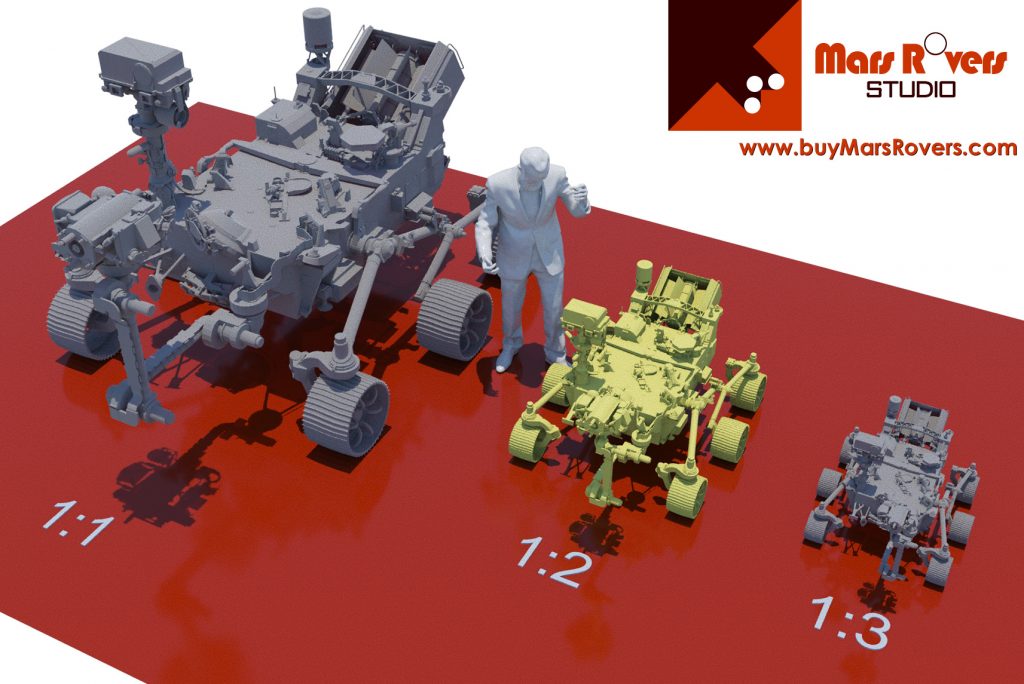The Mars 2020 Perseverance Rover‘s turret is located at the end of the 2.1-meter-long, 5-degree-freedom robotic arm. It carries the science instruments SHERLOC, WASTON, and PIXL to help with the sample handling process. Besides the three instruments, there are also the gDRT(Gaseous Dust Removal Tool) and the Corer. The Corer is positioned in the middle of the instruments. SHERLOC and WASTON are by one side of the Corer, while gDRT and PIXL are on the opposite side of the Corer. Collectively, they form the Mars 2020 Perseverance Rover‘s turret assembly. Our 1:2 Perseverance Mars Rover Replica will perfectly replicate the structure appearance of the Turret including the SHERLOC, WASTON, and PIXL instruments, the gDRT, and the Corer.
The Mars 2020 Perseverance Rover‘s SHERLOC, WATSON, and PIXL instruments are introduced in more detail in [PIXL of the Mars 2020 Perseverance Rover Part 1], [PIXL of the Mars 2020 Perseverance Rover Part 2], [SHERLOC of the Mars 2020 Perseverance Rover], and [WATSON of the Mars 2020 Perseverance Rover]. With these scientific instruments the Mars 2020 Perseverance Rover‘s turret carries, the Mars 2020 Perseverance Rover is able to analyze the minerals and chemicals to study whether or not there was life or if it will be possible for humans to live on Mars by carefully and scientifically selecting the most valuable rock and soil samples to collect. Our Perseverance Mars Rover Replica‘s PIXL and the tools on it won’t have the functions as the real Mars 2020 Perseverance Rover, but the Perseverance Mars Rover Replica‘s PIXL replica will stimulate the movement when operating.
After the Mars 2020 Perseverance Rover‘s robotic arm accurately transports the turret assembly to the location of interest, depending on what this specific mission’s purpose is, the corer will get one of the bits and will do an initial abrading operation. The Mars 2020 Perseverance Rover‘s turret then will rotate and find a position for gDRT to remove dust from the surface to prevent contamination preparing for the sample caching process. The gDRT is a sophisticated tool that consists of the following 7 components:
1. A supply tank with 159g of gaseous Nitrogen
2. A gas tank, or plenum tank which fills gas before every operation
3. Two supplementary supply valves for transferring gas from the supply tank to the plenum tank
4. A valve that releases the plenum tank’s gas
5. A nozzle that will blow the gas to the target surface
6. A valve that acts as the supply tank’s switch for releasing and loading gas before launch
7. A pressure transducer for the pressure reading
In the end, the Mars 2020 Perseverance Rover‘s turret will rotate to positions to allow SHERLOC, WASTON, and PIXL to work.
Our 1:2 Perseverance Mars Rover Replica will perfectly replicate the appearance structure of the gDRT down to very fine details, but it will not have the dust-removing function or the many components.
Other than the mentioned tools, the Mars 2020 Perseverance Rover‘s turret assembly carries a sensor, the Ground Contact Sensor. The Ground Contact Sensor’s job is to prevent the Mars 2020 Perseverance Rover‘s turret from accidentally touching the ground by giving the robotic arm signals to stop if the turret gets too close to the ground. Our Perseverance Mars Rover Replica will perfectly replicate the appearance structure of Ground Contact Sensor but it will not actually be a sensor.


